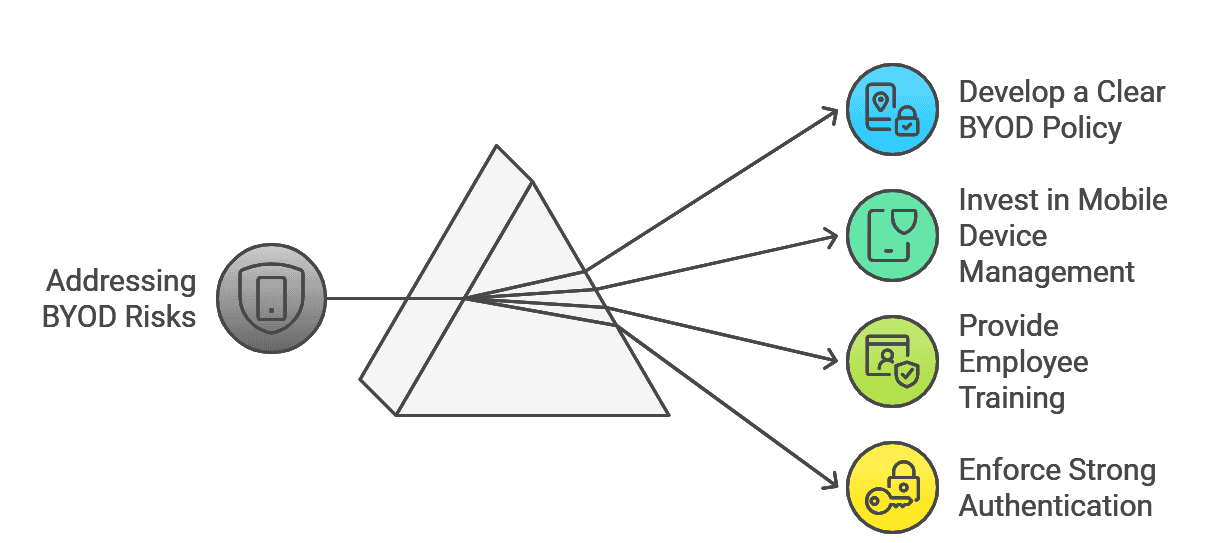
Bring Your Own Device (BYOD) policies have transformed the workplace, offering convenience and flexibility. However, they come with significant risks.
According to a study by Syntonic, 87% of organizations rely on employees using personal devices for work, yet only 24% have BYOD policies in place to mitigate risks. This lack of security creates vulnerabilities that can threaten your business.
Chris Power, CEO of Power Consulting, notes that “Organizations must balance BYOD flexibility with robust security measures to safeguard sensitive data.”
Ignoring these risks can lead to devastating consequences for any business. This blog explores BYOD risks, their impact, and actionable strategies to protect your business.
Empower Your Workplace with the Right Technology
Enhance productivity, improve collaboration, and secure your business with smart technology solutions tailored to your needs.
4 Most Common BYOD Security Risks
Understanding the most frequent BYOD risks helps you address vulnerabilities and safeguard your business data. These issues highlight why strong policies and tools are essential.
1. Data Leakage
Using personal devices increases the likelihood of sensitive data exposure. Employees may store business files on unsecured devices, making them vulnerable. Apps with weak security can also leak data. For example, cloud apps often lack encryption, exposing confidential information to third parties.
2. Unsecured Networks
Employees often work from public Wi-Fi, which poses severe BYOD security risks. Unsecured networks enable hackers to intercept data or inject malware into devices. These risks grow exponentially without a secure virtual private network (VPN).
3. Lack of Device Management
When employees bring personal devices, IT departments lose control over updates, antivirus installations, or patches. Unpatched vulnerabilities make devices an easy target for cyberattacks.
4. Insider Threats
While accidental insider threats often stem from negligence, intentional misuse of devices can compromise your systems. Personal devices complicate identifying malicious activity, adding another layer of problems with BYOD.
Risks of BYOD Policies Without Proper Planning
Poorly planned BYOD policies can expose your business to compliance violations, cyberattacks, and operational inefficiencies. Proactive measures are essential to mitigate these risks.
- Compliance Failures: Certain industries, such as healthcare and finance, have strict data protection laws. Without strong policies, BYOD risks can lead to non-compliance fines and reputation damage.
- Malware Attacks: BYOD opens the door for malware through unsecured apps and downloads. Even one infected device can spread malicious software across your network.
- Increased IT Workload: Allowing BYOD adds complexity to IT tasks. Your team must handle diverse devices, operating systems, and configurations, potentially straining resources.
How to Address BYOD Risks and Issues

Effectively managing BYOD risks and issues starts with proactive measures that safeguard company data and employee devices. Implement these strategies to reduce vulnerabilities:
- Develop a Clear BYOD Policy: Define acceptable use, security standards, and steps for handling lost or stolen devices. Clear guidelines reduce confusion and risks.
- Invest in Mobile Device Management (MDM)
Use MDM tools to encrypt data, manage apps, and remotely wipe devices when necessary. This secures sensitive information. - Provide Employee Training: 80% of organizations report that security awareness training has significantly reduced phishing susceptibility. Train employees on BYOD security risks and safe practices, like avoiding public Wi-Fi and recognizing phishing attempts.
- Enforce Strong Authentication: Multi-factor authentication (MFA) adds a robust layer of security, minimizing unauthorized access to your systems.
BYOD Policy Checklist for Businesses
Creating and enforcing a robust BYOD policy is key to minimizing BYOD risks and issues. Use this checklist to ensure your policy is comprehensive and secure.
| Checklist Item | Why It Matters |
| Device Registration Process | Ensures only authorized devices connect to company networks. |
| Mandatory Security Software | Protects against malware and unauthorized access with antivirus and firewalls. |
| Data Access Restrictions | Limits access to sensitive files based on role and device compliance. |
| Employee Training on BYOD Risks | Educates staff on identifying threats and practising safe device usage. |
| Incident Response Plan | Provides clear steps for reporting and mitigating lost or stolen devices. |
| Regular Policy Audits | Keeps policies updated to address emerging BYOD risks effectively. |
This checklist helps your business address problems with BYOD and enhance your overall security strategy.
| More articles you might like: |
Benefits of a Strong BYOD Risk Security Plan
A robust BYOD security plan balances flexibility with protection, offering significant advantages for businesses and employees alike.
Here’s how:
- Cost Savings: Reduce equipment expenses by utilizing employee devices while maintaining robust security to prevent data breaches.
- Employee Satisfaction: Empower employees with flexible BYOD policies backed by strong security, enhancing both satisfaction and productivity.
- Enhanced Productivity: Secure BYOD policies enable seamless remote work, allowing employees to stay efficient without compromising company data.
Proactive Monitoring and Incident Response for BYOD
A robust BYOD strategy isn’t just about preventing issues; it’s also about identifying and addressing them quickly. Proactive monitoring and an effective incident response plan can significantly reduce the impact of security events.
Real-Time Monitoring of Devices
Proactive monitoring tools track device activity, flagging suspicious behaviors such as unauthorized access attempts or data transfers. These tools offer visibility into all connected devices, ensuring you can identify potential threats early.
Incident Response Plans for BYOD
An incident response plan tailored for BYOD environments outlines clear steps to take when a security issue arises.
Key components include:
- Immediate Containment: Disconnect compromised devices from the network to limit exposure.
- Investigation Protocols: Use monitoring logs to trace the source and scope of the incident.
- Communication Plans: Inform affected parties and employees about the breach and the steps being taken.
- Recovery Measures: Restore affected systems and ensure all devices comply with updated security protocols.
Benefits of Proactive Measures
- Reduced Downtime: Address issues quickly to minimize business disruption.
- Improved Trust: Employees feel more secure knowing the company has a plan for BYOD-related incidents.
- Stronger Compliance: Meet regulatory requirements by demonstrating control over BYOD environments.
By combining proactive monitoring with a detailed incident response plan, you can address BYOD risks and issues effectively, protecting both your business and employee devices.
Strengthen Your Security and Reduce BYOD Risks with Power Consulting
Managing BYOD risks is critical to protecting your company’s sensitive data and maintaining operational security. Implementing clear policies, leveraging tools like MDM, and educating employees are essential steps to reduce vulnerabilities.
Power Consulting helps businesses secure their systems against BYOD risks and issues. With a 4-hour emergency response time and a proven ability to achieve a 50% reduction in hardware-related downtime, we deliver effective, tailored security solutions.
| Discover Trusted Cybersecurity Solutions in NYC |
Contact us today for a free consultation, and let us help you strengthen your defenses against potential threats.



